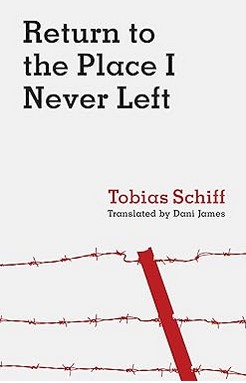Book Briefs
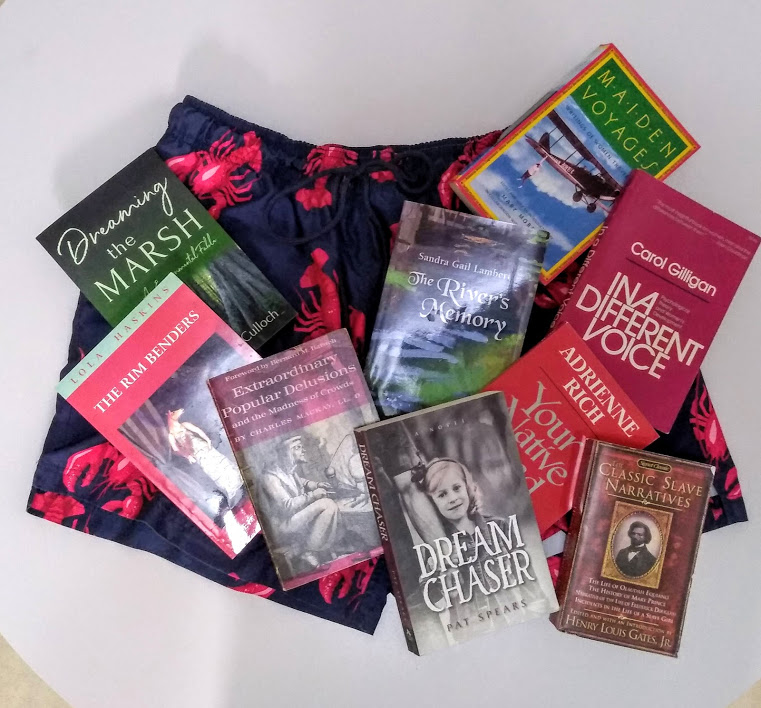
Full book reviews are at Big Books from Small Presses on the Blogs page.
Here are capsule reviews of other books I’ve liked.
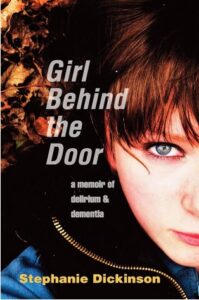 rThe Girl Behind the Door by Stephanie Dickinson. 2017. Many people write memoirs. They may have an unusual story to tell, or they’re working to heal trauma. Sometimes they have a message to deliver, or merely want to pin down their memories before they disappear. Most memoirs are awful. But memoir can be art when undertaken by a gifted, experienced writer, a master of her craft. Stephanie Dickinson has written a memoir of her mother Florence, framed around the months she lay dying with dementia in the memory care unit of a nursing home. She was a belle of the ball at soldier’s dances during World War II, a hard-working Iowa farm girl left with three small children when her husband died young, a dedicated teacher and demanding mother, simultaneously loving and horrified by her rebellious 1960’s daughter. Dickinson’s family comes alive; the natural beauty of Iowa is vividly portrayed. In the last few chapters Stephanie and her brothers come together in Iowa to empty out the house and bury their mother’s ashes, a picture of grief and mourning, as well as family bonds, that rang very true to me, and that I think I will never forget.
rThe Girl Behind the Door by Stephanie Dickinson. 2017. Many people write memoirs. They may have an unusual story to tell, or they’re working to heal trauma. Sometimes they have a message to deliver, or merely want to pin down their memories before they disappear. Most memoirs are awful. But memoir can be art when undertaken by a gifted, experienced writer, a master of her craft. Stephanie Dickinson has written a memoir of her mother Florence, framed around the months she lay dying with dementia in the memory care unit of a nursing home. She was a belle of the ball at soldier’s dances during World War II, a hard-working Iowa farm girl left with three small children when her husband died young, a dedicated teacher and demanding mother, simultaneously loving and horrified by her rebellious 1960’s daughter. Dickinson’s family comes alive; the natural beauty of Iowa is vividly portrayed. In the last few chapters Stephanie and her brothers come together in Iowa to empty out the house and bury their mother’s ashes, a picture of grief and mourning, as well as family bonds, that rang very true to me, and that I think I will never forget.
 Mary Oliver A Poetry Handbook (1994) I like reading poetry. For a long time I went on the Poetry Daily website almost daily, and printed out those that appealed (and that I could understand), so that now I have a jumbo looseleaf notebook filled with guaranteed Liz-pleasers. This book has deepened my understanding and delight. Clear discussions of the uses of sound, meter, imagery and more are to some extent reviewing what I once learned, but I never understood the use of line breaks, enjambment, caesura. I revisit poems and see what I didn’t before; I never did get the depth of Williams’ The Red Wheelbarrow; now I do. I intend to read the book again (it’s only a bit over 100 pages) to let the thoughts sink in.
Mary Oliver A Poetry Handbook (1994) I like reading poetry. For a long time I went on the Poetry Daily website almost daily, and printed out those that appealed (and that I could understand), so that now I have a jumbo looseleaf notebook filled with guaranteed Liz-pleasers. This book has deepened my understanding and delight. Clear discussions of the uses of sound, meter, imagery and more are to some extent reviewing what I once learned, but I never understood the use of line breaks, enjambment, caesura. I revisit poems and see what I didn’t before; I never did get the depth of Williams’ The Red Wheelbarrow; now I do. I intend to read the book again (it’s only a bit over 100 pages) to let the thoughts sink in.
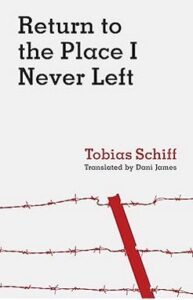 Schiff,Tobias. Return to the Place I Never Left (English version 2025) Dani James has translated this memoir in verse form of Schiff’s three years in eight Nazi concentration camps. He was seventeen when he was arrested. He lost his father, mother, and older sister and many other family members to the Holocaust. His writing begins and ends with the thought of what it is to lose them and to never lose or escape the memories. And in between, we have the memories, of cold, starvation, beatings, murders, as well as small instances of kindness, of connection. The language is plain, straightforward, simple. It doesn’t describe emotions; the vivid accounts evoke them directly in the reader. I have read a number of books, fiction and nonfiction, about the Holocaust. I believe this is the most moving I have ever read.
Schiff,Tobias. Return to the Place I Never Left (English version 2025) Dani James has translated this memoir in verse form of Schiff’s three years in eight Nazi concentration camps. He was seventeen when he was arrested. He lost his father, mother, and older sister and many other family members to the Holocaust. His writing begins and ends with the thought of what it is to lose them and to never lose or escape the memories. And in between, we have the memories, of cold, starvation, beatings, murders, as well as small instances of kindness, of connection. The language is plain, straightforward, simple. It doesn’t describe emotions; the vivid accounts evoke them directly in the reader. I have read a number of books, fiction and nonfiction, about the Holocaust. I believe this is the most moving I have ever read.
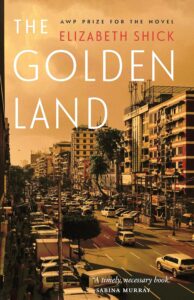 The Golden Land by Elizabeth Shick (2021). This is a fascinating novel about a woman revisiting a critical time and place in her life. At 13, she and her family visited Burma (now Myanmar), their ancestral home, and she fell in love with her young cousin there. Dallying in the park, they witnessed the massacre of young protestors by troops of the military regime, and the family quickly returned to the US. The story begins twenty-three years later with the death of Etta’s grandmother, matriarch of the family. Her sister insists on burying the ashes in Burma. Etta follows her there, reconnects with her cousin, and learns the many secrets her grandmother held close. Shick gives us a vivid picture of Myanmar, where she lived for six years. She explores Etta’s complex relationships: with the grandmother who mostly raised her, the younger sister who is now an adult, the cousin, now a taxi driver and radical journalist, and the fiancé she left behind in Boston. Initially naïve, Etta grows in understanding. I was engrossed by both the characters and the setting; the book is a page turner in the best sense of the word.
The Golden Land by Elizabeth Shick (2021). This is a fascinating novel about a woman revisiting a critical time and place in her life. At 13, she and her family visited Burma (now Myanmar), their ancestral home, and she fell in love with her young cousin there. Dallying in the park, they witnessed the massacre of young protestors by troops of the military regime, and the family quickly returned to the US. The story begins twenty-three years later with the death of Etta’s grandmother, matriarch of the family. Her sister insists on burying the ashes in Burma. Etta follows her there, reconnects with her cousin, and learns the many secrets her grandmother held close. Shick gives us a vivid picture of Myanmar, where she lived for six years. She explores Etta’s complex relationships: with the grandmother who mostly raised her, the younger sister who is now an adult, the cousin, now a taxi driver and radical journalist, and the fiancé she left behind in Boston. Initially naïve, Etta grows in understanding. I was engrossed by both the characters and the setting; the book is a page turner in the best sense of the word.
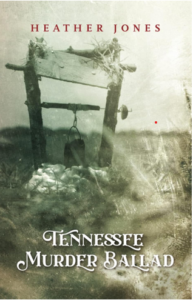 Heather Jones, Tennessee Murder Ballad (2023) “The mountains cast spells on all who traversed their ridges, their hollows, their forests. Magic threaded through them, spring to stream, stream to river…” A lyrical story of curses and magic, this novel of life in a Tennessee mountain village after the Civil War is introduced by the “true” story of Ellen Bridges, the herbalist-midwife who welcomes the village children to her home, where they happily play and learn together. A traveling preacher, determined to destroy the witch, murders her by pushing her into a well, and the children send him down after her, but before he dies he curses them and their village. The novel itself begins eighteen years later in 1866, a year after the war ends. It’s told from the point of view of each of the children, now grown, and carries us through their connected lives to the terrifying fulfillment of the preacher’s curse. Jones creates a distinct voice for each character, and vividly depicts their mountain home. Followed by The Ballad of Ellen Bridge, this tale has the tone of old legend, and underlying it all is the curse of war. As Willie Reed says, “Maybe [the battlefield] did look like vengeance and redemption to some, but I don’t know how. It weren’t no sight of pride, nor saving of a union nor saving any man from bondage. It weren’t nothing but mud made of blood and dirt. Nothing but men butchering men and land ‘til the world choked on the smell of destruction.”
Heather Jones, Tennessee Murder Ballad (2023) “The mountains cast spells on all who traversed their ridges, their hollows, their forests. Magic threaded through them, spring to stream, stream to river…” A lyrical story of curses and magic, this novel of life in a Tennessee mountain village after the Civil War is introduced by the “true” story of Ellen Bridges, the herbalist-midwife who welcomes the village children to her home, where they happily play and learn together. A traveling preacher, determined to destroy the witch, murders her by pushing her into a well, and the children send him down after her, but before he dies he curses them and their village. The novel itself begins eighteen years later in 1866, a year after the war ends. It’s told from the point of view of each of the children, now grown, and carries us through their connected lives to the terrifying fulfillment of the preacher’s curse. Jones creates a distinct voice for each character, and vividly depicts their mountain home. Followed by The Ballad of Ellen Bridge, this tale has the tone of old legend, and underlying it all is the curse of war. As Willie Reed says, “Maybe [the battlefield] did look like vengeance and redemption to some, but I don’t know how. It weren’t no sight of pride, nor saving of a union nor saving any man from bondage. It weren’t nothing but mud made of blood and dirt. Nothing but men butchering men and land ‘til the world choked on the smell of destruction.”
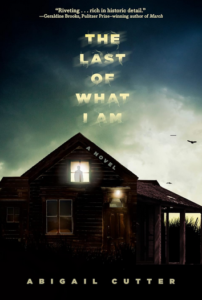 Abigail Cutter. The Last of What I Am (2022) This novel focuses on a Confederate soldier and his family, It portrays the horrors of battle and prison camp, and the devastation of the homefront. It’s told from the point of view of the soldier’s ghost as he watches a young couple restore and desecrate his old family homestead. Though I found that device rather forced, it made sense at the end as the ghost is redeemed from his guilt, and it doesn’t interfere with the vivid account of the horror and futility of war, fought by the poor to defend the interests, including slavery, of the rich. The author has transformed extensive research into a compelling story, rich in detail, and the writing is clear and lyrical.
Abigail Cutter. The Last of What I Am (2022) This novel focuses on a Confederate soldier and his family, It portrays the horrors of battle and prison camp, and the devastation of the homefront. It’s told from the point of view of the soldier’s ghost as he watches a young couple restore and desecrate his old family homestead. Though I found that device rather forced, it made sense at the end as the ghost is redeemed from his guilt, and it doesn’t interfere with the vivid account of the horror and futility of war, fought by the poor to defend the interests, including slavery, of the rich. The author has transformed extensive research into a compelling story, rich in detail, and the writing is clear and lyrical.
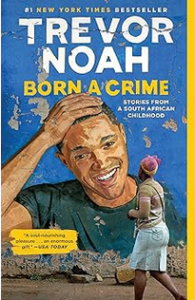 Born a Crime by Trevor Noah (2019) Told in 18 separate essay-stories, this memoir of childhood is a portrait of a fierce and determined mother, a loving extended family, and a bright, mischievous little boy who grew up as an outsider to every group. Born during apartheid to a black South African mother and a white Swiss father, Trevor Noah’s existence was evidence of a crime, so that his family tried to keep him hidden when he was small. It gives us a detailed picture of the complexity of race in a country that had four legal racial categories (black, white, colored, Indian), ruled with an iron fist by whites, the smallest group. Blacks, the largest group, came from many different tribes; there are over 35 languages spoken in South Africa, twelve of them official. Noah’s wit and understanding are so subtle and deep, and apartheid and its aftermath so complicated that I can’t possibly do justice to this book. I can only say, “Read it.”
Born a Crime by Trevor Noah (2019) Told in 18 separate essay-stories, this memoir of childhood is a portrait of a fierce and determined mother, a loving extended family, and a bright, mischievous little boy who grew up as an outsider to every group. Born during apartheid to a black South African mother and a white Swiss father, Trevor Noah’s existence was evidence of a crime, so that his family tried to keep him hidden when he was small. It gives us a detailed picture of the complexity of race in a country that had four legal racial categories (black, white, colored, Indian), ruled with an iron fist by whites, the smallest group. Blacks, the largest group, came from many different tribes; there are over 35 languages spoken in South Africa, twelve of them official. Noah’s wit and understanding are so subtle and deep, and apartheid and its aftermath so complicated that I can’t possibly do justice to this book. I can only say, “Read it.”
Naming Nature (2009) by Carol Kaesuk Yoon.  This is a lively, informative account, complete with illustrations, of the history of taxonomy, from the Victorian naturalists struggling to differentiate one species from another with careful observation and intuition, through the evolutionary taxonomists who shifted their approach to accommodate Darwin’s revolutionary theory, through the numerical taxonomists who entered every conceivable characteristic of a specimen into a computer, to the molecular biologists who compared DNA to find evolutionary relationships. It explores the umwelt, a system for ordering and classifying nature that appears to operate by common rules across cultures. If I read this summary I would NOT buy the book, but Yoon’s writing is witty, vivid and clear, filled with gems, eg, “More than two hundred years ago, scientists began a quest to order and name the entire living world – the whole squawking, scuttling, blooming, leafy, furry, green and wondrous mess of it.” Yoon and Miller (Why Fish Don’t Exist) are luring me away from fiction into natural history. Just maybe I’ll try Origin of Species. I do love Victorian writing.
This is a lively, informative account, complete with illustrations, of the history of taxonomy, from the Victorian naturalists struggling to differentiate one species from another with careful observation and intuition, through the evolutionary taxonomists who shifted their approach to accommodate Darwin’s revolutionary theory, through the numerical taxonomists who entered every conceivable characteristic of a specimen into a computer, to the molecular biologists who compared DNA to find evolutionary relationships. It explores the umwelt, a system for ordering and classifying nature that appears to operate by common rules across cultures. If I read this summary I would NOT buy the book, but Yoon’s writing is witty, vivid and clear, filled with gems, eg, “More than two hundred years ago, scientists began a quest to order and name the entire living world – the whole squawking, scuttling, blooming, leafy, furry, green and wondrous mess of it.” Yoon and Miller (Why Fish Don’t Exist) are luring me away from fiction into natural history. Just maybe I’ll try Origin of Species. I do love Victorian writing.
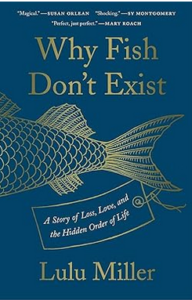 Miller follows David Starr Jordan, first president of Stanford University. In his youth an avid taxonomist who believed in bright line categories – species, genus, class – he gradually accepted Darwin’s theory of evolution, with his own take on it. He believed species could devolve as well as evolve. He imposed human moral standards on species’ behavior: idleness, parasitism would lead to the species’ degeneration. He eventually became a leader in the early twentieth century eugenics movement. When a member of Stanford’s board of trustees became critical of him, she was murdered. Clues pointed to Jordan, but the case was never solved. Miller takes many side trips in her account of Jordan’s life and follies, including philosophers’ take on categories, her own romantic heartbreak, an account of her childhood with a brilliant eccentric father.The book ends with a discussion of a revolution in taxonomy, which concludes that “fish” don’t exist – our current categories classify by irrelevant rather than meaningful characteristics. Miller convincingly connects diverse concepts where most would see no connection. And she does it with rollicking prose, presenting complex, disturbing ideas with a light touch. Kate Samworth’s vivid engravings of monstrous or mythical creatures enhance this delightful book. Pub.date 2020.
Miller follows David Starr Jordan, first president of Stanford University. In his youth an avid taxonomist who believed in bright line categories – species, genus, class – he gradually accepted Darwin’s theory of evolution, with his own take on it. He believed species could devolve as well as evolve. He imposed human moral standards on species’ behavior: idleness, parasitism would lead to the species’ degeneration. He eventually became a leader in the early twentieth century eugenics movement. When a member of Stanford’s board of trustees became critical of him, she was murdered. Clues pointed to Jordan, but the case was never solved. Miller takes many side trips in her account of Jordan’s life and follies, including philosophers’ take on categories, her own romantic heartbreak, an account of her childhood with a brilliant eccentric father.The book ends with a discussion of a revolution in taxonomy, which concludes that “fish” don’t exist – our current categories classify by irrelevant rather than meaningful characteristics. Miller convincingly connects diverse concepts where most would see no connection. And she does it with rollicking prose, presenting complex, disturbing ideas with a light touch. Kate Samworth’s vivid engravings of monstrous or mythical creatures enhance this delightful book. Pub.date 2020.
 Janisse Ray, author of Ecology of a Cracker Childhood, has written a novel. The Woods of Fannin County is closely based on the true story of eight children, aged 3 months to 10 years, whose mother left them in the 1940’s in a cabin deep in the north Georgia woods. For a short time she came every few days, bringing corn they could turn into hominy, then once in a while, then not at all. Several people knew the children were there but did nothing; one storekeeper supplied them for a while, then stopped. After four years someone finally intervened, and they were taken to an orphanage. Ray interviewed the survivors, now in their 70’s, and Bobby, her point of view character, draws on everything she learned. She is a renowned nature writer who loves language almost as much as she loves the southern woods, and succeeds in fiction as she has succeeded in her many books and essays, creating characters as real and compelling as the mountainous woods they live in. (Janisse Ray’s essays are available on Substack.)
Janisse Ray, author of Ecology of a Cracker Childhood, has written a novel. The Woods of Fannin County is closely based on the true story of eight children, aged 3 months to 10 years, whose mother left them in the 1940’s in a cabin deep in the north Georgia woods. For a short time she came every few days, bringing corn they could turn into hominy, then once in a while, then not at all. Several people knew the children were there but did nothing; one storekeeper supplied them for a while, then stopped. After four years someone finally intervened, and they were taken to an orphanage. Ray interviewed the survivors, now in their 70’s, and Bobby, her point of view character, draws on everything she learned. She is a renowned nature writer who loves language almost as much as she loves the southern woods, and succeeds in fiction as she has succeeded in her many books and essays, creating characters as real and compelling as the mountainous woods they live in. (Janisse Ray’s essays are available on Substack.)
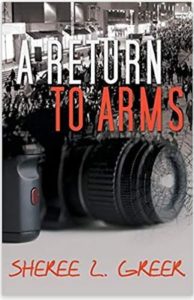 At first a little didactic, this story comes alive as Tori, a photographer and one of a Black Lives Matter cadre in St Petersburg, Florida, wields her camera at a demonstration. It follows the conflicts among the group, and Tori’s attraction to 2 very different women. A policeman stops the group driving home from a rally: the depiction of their careful response, controlling their terror and rage, is as powerful and vivid as anything I’ve read. Though I’ve raised, and feared for, a Black granddaughter, Greer conveys the scene with a chilling reality I’ve never imagined. After another rally, the story end in a way that seems to break all rules of fiction, and adds to its power.
At first a little didactic, this story comes alive as Tori, a photographer and one of a Black Lives Matter cadre in St Petersburg, Florida, wields her camera at a demonstration. It follows the conflicts among the group, and Tori’s attraction to 2 very different women. A policeman stops the group driving home from a rally: the depiction of their careful response, controlling their terror and rage, is as powerful and vivid as anything I’ve read. Though I’ve raised, and feared for, a Black granddaughter, Greer conveys the scene with a chilling reality I’ve never imagined. After another rally, the story end in a way that seems to break all rules of fiction, and adds to its power.
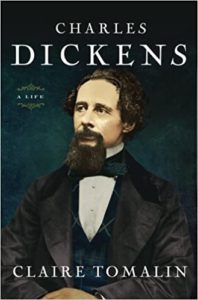 Claire Tomalin’s Charles Dickens. A Life is a brilliant biography. Fat, thorough biographies can be tough going, but Tomalin races through lists of his travels and dinners with friends while giving full accounts of the more interesting aspects of Dickens’ life. She does brief critical analyses of each novel, and throughout the book, ponders the enigma of the man who was a mix of philanthropist, bon vivant, and cruel, implacable enemy of those who have offended him. She loves Dickens the author and Dickens the man. His generosity, his creativity, his energy and enthusiasm were larger than life, but she holds him accountable for his sins, particularly his treatment of his wife and some of his many children.
Claire Tomalin’s Charles Dickens. A Life is a brilliant biography. Fat, thorough biographies can be tough going, but Tomalin races through lists of his travels and dinners with friends while giving full accounts of the more interesting aspects of Dickens’ life. She does brief critical analyses of each novel, and throughout the book, ponders the enigma of the man who was a mix of philanthropist, bon vivant, and cruel, implacable enemy of those who have offended him. She loves Dickens the author and Dickens the man. His generosity, his creativity, his energy and enthusiasm were larger than life, but she holds him accountable for his sins, particularly his treatment of his wife and some of his many children.
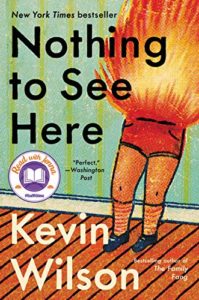 Nothing to See Here by Kevin Wilson. This is such a surprising book. It begins with laugh-out-loud lines as a story about a poor girl and a rich girl who become best friends in boarding school. They go their separate ways and then reconnect when the rich girl is even richer, married to an older man with presidential aspirations. She asks the poor girl, who is drifting and lost, to be a governess to her two stepchildren. The plot unfolds in a comfortably interesting way until embodied psychological horror intrudes. It resonated strongly with me, a former foster mother to deeply troubled children.
Nothing to See Here by Kevin Wilson. This is such a surprising book. It begins with laugh-out-loud lines as a story about a poor girl and a rich girl who become best friends in boarding school. They go their separate ways and then reconnect when the rich girl is even richer, married to an older man with presidential aspirations. She asks the poor girl, who is drifting and lost, to be a governess to her two stepchildren. The plot unfolds in a comfortably interesting way until embodied psychological horror intrudes. It resonated strongly with me, a former foster mother to deeply troubled children.
After almost fifty years in north Florida, I still love reading about this place. If you share my passion, or even if you don’t but would like to venture out, I recommend these two very different books.
 Pumping Sunshine by Susie Baxter: This is an episodic memoir of 1940’s life on a small farm on the Suwannee River. Baxter and her two older sisters grew up in a four-room cracker-style house; her grandparents and great grandparents lived just down the dirt road. In clear, unobtrusive prose Baxter describes a lost world and time: the annual hog killing, soap-making, the floods that destroyed the tobacco crop, her uncle building an outhouse so they no longer had to pee in the woods. She portrays it all through her own childhood eyes, with its sense of wonder and delight, of fear and insecurity, and most of all a child’s unquestioning acceptance of the world she lives in. Funny, frightening, heart-warming, chilling, her stories portray the warmth and complexity of family life and the natural beauty of Florida.
Pumping Sunshine by Susie Baxter: This is an episodic memoir of 1940’s life on a small farm on the Suwannee River. Baxter and her two older sisters grew up in a four-room cracker-style house; her grandparents and great grandparents lived just down the dirt road. In clear, unobtrusive prose Baxter describes a lost world and time: the annual hog killing, soap-making, the floods that destroyed the tobacco crop, her uncle building an outhouse so they no longer had to pee in the woods. She portrays it all through her own childhood eyes, with its sense of wonder and delight, of fear and insecurity, and most of all a child’s unquestioning acceptance of the world she lives in. Funny, frightening, heart-warming, chilling, her stories portray the warmth and complexity of family life and the natural beauty of Florida.
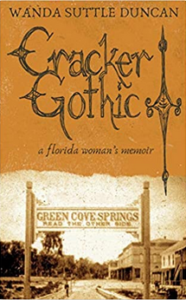 Cracker Gothic by Wanda Suttle Duncan: Once a late 19th Century winter resort on the St Johns River, Green Cove Springs is now a three-spotlight town overlooked by everyone but the town natives. Duncan left her childhood home the minute she turned 18 but returned years later to care for her mother. In these short essays, written with warmth, wit and an adept mastery of language, she moves back and forth from the quirky weirdness of the place and its people, to grief over the loss of her father and husband, to the challenges of caring for a stubborn woman with dementia. Pub.date 2019
Cracker Gothic by Wanda Suttle Duncan: Once a late 19th Century winter resort on the St Johns River, Green Cove Springs is now a three-spotlight town overlooked by everyone but the town natives. Duncan left her childhood home the minute she turned 18 but returned years later to care for her mother. In these short essays, written with warmth, wit and an adept mastery of language, she moves back and forth from the quirky weirdness of the place and its people, to grief over the loss of her father and husband, to the challenges of caring for a stubborn woman with dementia. Pub.date 2019
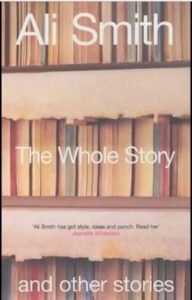 i’d never heard of this author, but she is much acclaimed and awarded, and short-listed for the Booker. Sometimes I feel as though I’m living in a dark cupboard. Ali Smith is preoccupied with stories. First in this collection is an examination of story-telling, a writer trying to figure out where to start and what to include. It’s perhaps about a book in a used-book store, but at one point the narrator gets so off course that she writes from the point of view of a fly who has landed on the book, giving us his complete life history. In another, a woman falls in love with a tree, and her husband despairs as she sits precariously in the attic window watching everything that happens in and around it. Smith looks at the world with a slightly skewed vision. Her precise descriptions cast a new light on the ordinary, making it wonderfully strange. Her voice is dry, blunt, almost childishly direct, and the effect is very funny.
i’d never heard of this author, but she is much acclaimed and awarded, and short-listed for the Booker. Sometimes I feel as though I’m living in a dark cupboard. Ali Smith is preoccupied with stories. First in this collection is an examination of story-telling, a writer trying to figure out where to start and what to include. It’s perhaps about a book in a used-book store, but at one point the narrator gets so off course that she writes from the point of view of a fly who has landed on the book, giving us his complete life history. In another, a woman falls in love with a tree, and her husband despairs as she sits precariously in the attic window watching everything that happens in and around it. Smith looks at the world with a slightly skewed vision. Her precise descriptions cast a new light on the ordinary, making it wonderfully strange. Her voice is dry, blunt, almost childishly direct, and the effect is very funny.
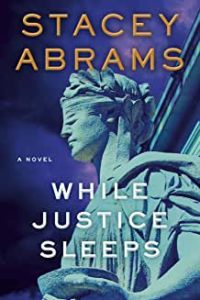 While Justice Sleeps by Stacey Abrams. With their tangles of clues and schemes and revelations I’m not a fan of thrillers or mysteries; I can never follow the tangle. However, I am a HUGE admirer of Stacey Abrams, and couldn’t resist reading While Justice Sleeps, which includes the Supreme Court, POTUS, FBI, Homeland Security, weaponized scientists, and the main character, an endearing Supreme Court clerk with a drug-addicted loving mother. I got lost in masses of information about genetic research, the complexity of surveillance and counter-surveillance measures, and too many good guys and bad guys running around. But Abrams has a genius for plot, suspense, character, and pace; even with my confusion, I couldn’t put it down. Stacey Abrams, While Justice Sleeps, Pub 2021
While Justice Sleeps by Stacey Abrams. With their tangles of clues and schemes and revelations I’m not a fan of thrillers or mysteries; I can never follow the tangle. However, I am a HUGE admirer of Stacey Abrams, and couldn’t resist reading While Justice Sleeps, which includes the Supreme Court, POTUS, FBI, Homeland Security, weaponized scientists, and the main character, an endearing Supreme Court clerk with a drug-addicted loving mother. I got lost in masses of information about genetic research, the complexity of surveillance and counter-surveillance measures, and too many good guys and bad guys running around. But Abrams has a genius for plot, suspense, character, and pace; even with my confusion, I couldn’t put it down. Stacey Abrams, While Justice Sleeps, Pub 2021
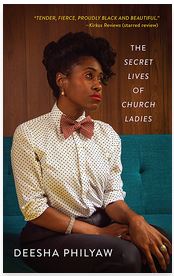 The Secret Lives of Church Ladies by Deeshaw Philyaw. Lively, tender, funny – these stories are easy reading with deep truths running through them. I particularly liked Peach Cobbler, about the little girl whose mother feeds their preacher peach cobbler and love, who hears Oh God Oh God coming from the bedroom and naturally thinks the preacher is God Himself. A lovely book. Pub. date 2020.
The Secret Lives of Church Ladies by Deeshaw Philyaw. Lively, tender, funny – these stories are easy reading with deep truths running through them. I particularly liked Peach Cobbler, about the little girl whose mother feeds their preacher peach cobbler and love, who hears Oh God Oh God coming from the bedroom and naturally thinks the preacher is God Himself. A lovely book. Pub. date 2020.
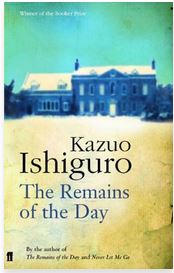 This tragicomic novel about aristocratic England in the years between the World Wars is narrated by Stevens, the butler in a ‘stately home.’ He gradually reveals but never quite acknowledges that his hero Lord Darlington is a tool in the hands of the Germans and that he himself has forfeited his chance for domestic happiness. With profound compassion, Ishiguro creates a character dedicated to and ruled by an archaic class system, while gently poking at his ideals of service and dignity. (Stevens’ diligent attempts to learn the art of banter to suit his post-war employer, an American businessman, made me laugh out loud.) Ishiguro reveals a broad world through a narrow and constricted view, and his insight into the character made me care deeply about Stevens, a man with whom I probably have nothing in common. Pub date 1989
This tragicomic novel about aristocratic England in the years between the World Wars is narrated by Stevens, the butler in a ‘stately home.’ He gradually reveals but never quite acknowledges that his hero Lord Darlington is a tool in the hands of the Germans and that he himself has forfeited his chance for domestic happiness. With profound compassion, Ishiguro creates a character dedicated to and ruled by an archaic class system, while gently poking at his ideals of service and dignity. (Stevens’ diligent attempts to learn the art of banter to suit his post-war employer, an American businessman, made me laugh out loud.) Ishiguro reveals a broad world through a narrow and constricted view, and his insight into the character made me care deeply about Stevens, a man with whom I probably have nothing in common. Pub date 1989
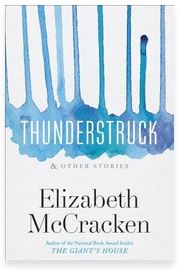 McCracken has deep insight into human nature and relationships; her characters stumble along, doing their best, making do, often in heart-breaking situations. Her descriptions of scenes and people aren’t mere decoration; they deepen the story with economy, accuracy and wit. The last story, almost novella-length, is stunning – I will read it again when I have recovered. Pub date 2014.
McCracken has deep insight into human nature and relationships; her characters stumble along, doing their best, making do, often in heart-breaking situations. Her descriptions of scenes and people aren’t mere decoration; they deepen the story with economy, accuracy and wit. The last story, almost novella-length, is stunning – I will read it again when I have recovered. Pub date 2014.
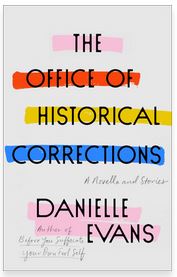 I enjoyed each story, and then came to the novella at the end. Evans blends many subplots in what initially seems like a straightforward, humorous story of an earnest young woman working for the Office of Historical Corrections, their mission to untangle the misinformation and lies that turn history into myth. As Cassie, a former history professor, researches a disputed historical plaque, she contends with a historian who has been her nemesis all through childhood and uncovers layers that lead her to a surprising truth. It’s astonishing what Evans managed to do in 100 pages. Pub date 2020
I enjoyed each story, and then came to the novella at the end. Evans blends many subplots in what initially seems like a straightforward, humorous story of an earnest young woman working for the Office of Historical Corrections, their mission to untangle the misinformation and lies that turn history into myth. As Cassie, a former history professor, researches a disputed historical plaque, she contends with a historian who has been her nemesis all through childhood and uncovers layers that lead her to a surprising truth. It’s astonishing what Evans managed to do in 100 pages. Pub date 2020
 This novel, which spans two World Wars, gives us a vivid picture of life in a northern Italian village. It is a moving, suspenseful, and thoroughly satisfying story of powerful women enduring great hardship, and of a married love that survived many years of separation. Pub date 2021
This novel, which spans two World Wars, gives us a vivid picture of life in a northern Italian village. It is a moving, suspenseful, and thoroughly satisfying story of powerful women enduring great hardship, and of a married love that survived many years of separation. Pub date 2021
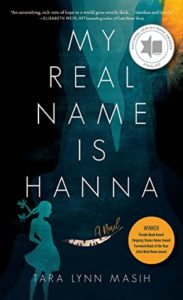 This profoundly moving novel takes us from Ukrainian village to abandoned forest cabins to caves deep underground, as several families of Jews struggle to survive the Holocaust. It is told through the eyes of a young teenaged girl, oldest of three children, and was inspired by a documentary, No Place on Earth, about Jewish families hiding in caves to escape the Germans.
This profoundly moving novel takes us from Ukrainian village to abandoned forest cabins to caves deep underground, as several families of Jews struggle to survive the Holocaust. It is told through the eyes of a young teenaged girl, oldest of three children, and was inspired by a documentary, No Place on Earth, about Jewish families hiding in caves to escape the Germans.
Masih brings her extensive historical research to life through the magic of fiction. Like the best historical fiction writers – I’m thinking of Kevin Baker, Amor Towles, Genevieve Graham, Anthony Doerr – she transports us entirely to another place and time, seamlessly weaving her hard-acquired knowledge into the story. Her lyrical prose paints vivid pictures of the village and forest. She imagines the lives of constant peril, starvation, and the “darker than dark” of the caves. The suspense is almost unbearable; because the characters are fully-imagined, we care deeply about their plight, as they care deeply about each other. Pub.date 2019
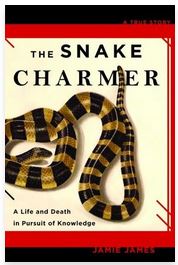 I don’t like snakes – I learned my mother’s phobia. I don’t like arrogant, macho men. But this book about snakes and the life and death of a swaggering herpetologist fascinated me. James alternates chapters about particular species with the narrative of Joe Slovinski’s life. I can’t say I came to like either Joe or his favorite creatures, but I gained some understanding of both. Pub. date 2008
I don’t like snakes – I learned my mother’s phobia. I don’t like arrogant, macho men. But this book about snakes and the life and death of a swaggering herpetologist fascinated me. James alternates chapters about particular species with the narrative of Joe Slovinski’s life. I can’t say I came to like either Joe or his favorite creatures, but I gained some understanding of both. Pub. date 2008
 Leonard Peltier has been in federal prison 43 years. In the 1960’s he was a leader of the American Indian Movement, and his account of the events of that time, and of his arrest and conviction for the murder of two FBI agents, make a persuasive case that he was convicted on fabricated evidence. This memoir and meditation, published in 1999, taught me a lot about AIM, life on the Pine Ridge reservation, and Indian spiritual life and practice. More than that, it reveals a man who was not destroyed by (then 23) years of wrongful imprisonment. It reminds me a bit of Mandela’s memoir Long Walk to Freedom, and in fact Mandela was one of many who supported the still-continuing fight to free Peltier. Pub date 1999
Leonard Peltier has been in federal prison 43 years. In the 1960’s he was a leader of the American Indian Movement, and his account of the events of that time, and of his arrest and conviction for the murder of two FBI agents, make a persuasive case that he was convicted on fabricated evidence. This memoir and meditation, published in 1999, taught me a lot about AIM, life on the Pine Ridge reservation, and Indian spiritual life and practice. More than that, it reveals a man who was not destroyed by (then 23) years of wrongful imprisonment. It reminds me a bit of Mandela’s memoir Long Walk to Freedom, and in fact Mandela was one of many who supported the still-continuing fight to free Peltier. Pub date 1999
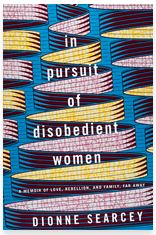 The reporting on life in Western Africa, especially the lives of women and the girls kidnapped by Boko Haram, is absolutely fascinating, and makes the book worth reading. I had an unfair and sour response to Searcey’s account of her struggles to balance family with the demands of her fascinating work. I was there in the 1970’s and each subsequent generation of women seems to approach it with surprised dismay. Usually I am MUCH more empathetic. I think all my responses to books are colored by what someone has called the “coronacoaster” of emotions – up one day, down the next. Pub. date 2020
The reporting on life in Western Africa, especially the lives of women and the girls kidnapped by Boko Haram, is absolutely fascinating, and makes the book worth reading. I had an unfair and sour response to Searcey’s account of her struggles to balance family with the demands of her fascinating work. I was there in the 1970’s and each subsequent generation of women seems to approach it with surprised dismay. Usually I am MUCH more empathetic. I think all my responses to books are colored by what someone has called the “coronacoaster” of emotions – up one day, down the next. Pub. date 2020
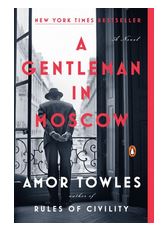 Though I heard the raves, I avoided A Gentleman in Moscow for several years because the title put me off. For some reason I thought it was a spy thriller, and those don’t appeal to me. I finally caved to common wisdom, and found a whole world within the pages, though the action is confined to the four walls of a hotel where the Bolsheviks have sentenced a thirty-year-old aristocrat to live out his days.
Though I heard the raves, I avoided A Gentleman in Moscow for several years because the title put me off. For some reason I thought it was a spy thriller, and those don’t appeal to me. I finally caved to common wisdom, and found a whole world within the pages, though the action is confined to the four walls of a hotel where the Bolsheviks have sentenced a thirty-year-old aristocrat to live out his days.
The book started slowly, but grabbed me with wit and masterful prose. It took off when 9-year-old Nina boldly approached Count Rostov in the hotel restaurant to ask where his moustache had gone. [I immediately thought of Kay Thomson and Hilary Knight’s Eloise, who lived and wreaked havoc at the Plaza in New York, and when I searched Goodreads for Eloise’s publication date I found Amor Towles saying that Eloise is reminiscent of his book.]
The Count has a full life in the hotel for over thirty years, with close friendships, romance, and the best of food and wine, all enlivened by Nina and her successor. The story ends with a suspenseful adventure and just the conclusion you would hope for. This is an entirely satisfying book. Pub date 2016
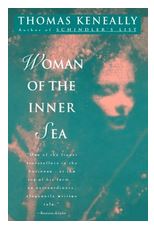
There is so much going on in this book. As a reader I was engrossed by the twists and turns in the story, the questions that kept me wondering until the end, the tormented character of Kate and the friends she makes in her journey to escape her tragedy and guilt. As a writer I kept trying to figure out all the different ways Kenneally approaches his story, admired his complete mastery and seeming confidence. I particularly loved the growing importance of the two iconic Australian creatures, the kangaroo and the emu,. Her friend rescued and raised them “from pouch and egg,” and they become spirit guides for Kate as she tries to bury her old self. It’s a wonderful book, and I want to read more Kenneally. Pub date 1992
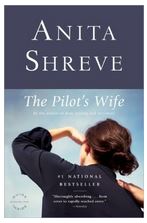 The writing is beautiful, the characters complex and well-examined, and the plot gripped me to the very end. I particularly liked Julia the grandmother,: who confidently delivers advice based on her own invented facts, such as don’t cry in public; you’ll catch a cold, because the irritated mucous membranes will be susceptible to the alien microbes. She reminds me of me. Pub date 1998
The writing is beautiful, the characters complex and well-examined, and the plot gripped me to the very end. I particularly liked Julia the grandmother,: who confidently delivers advice based on her own invented facts, such as don’t cry in public; you’ll catch a cold, because the irritated mucous membranes will be susceptible to the alien microbes. She reminds me of me. Pub date 1998
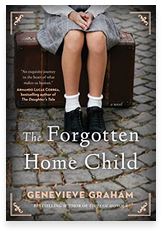 This is a story of a lost portion of Canadian history, when children were sent from the slums and orphanages of England to work as indentured servants for Canadian families. It’s told primarily through the eyes of two of the children, and a very old woman recalling her extremely abusive childhood. The portrait of the physical and psychological scars is compelling, as is the redemption and happiness some of these children find, especially in their love for each other. Pub date 2020
This is a story of a lost portion of Canadian history, when children were sent from the slums and orphanages of England to work as indentured servants for Canadian families. It’s told primarily through the eyes of two of the children, and a very old woman recalling her extremely abusive childhood. The portrait of the physical and psychological scars is compelling, as is the redemption and happiness some of these children find, especially in their love for each other. Pub date 2020
 I’ve heard of Maxwell Perkins all my life. And I like reading letters (though I haven’t finished these yet – I go back to them in between novels – there are a LOT of letters). It’s always interesting to see inside the collaborative work of an editor and author. The characters of Max and Marjorie come through so clearly – each had oddities and weaknesses. I was amused at Max’s unwillingness to go to Cross Creek despite Marjorie’s constant urging, though he’d hang out with Hemingway anywhere. I share her love of this part of Florida, and I used to urge my northcentric and eurocentric family to visit, but I’ve given up with most of them. Pub date 1999
I’ve heard of Maxwell Perkins all my life. And I like reading letters (though I haven’t finished these yet – I go back to them in between novels – there are a LOT of letters). It’s always interesting to see inside the collaborative work of an editor and author. The characters of Max and Marjorie come through so clearly – each had oddities and weaknesses. I was amused at Max’s unwillingness to go to Cross Creek despite Marjorie’s constant urging, though he’d hang out with Hemingway anywhere. I share her love of this part of Florida, and I used to urge my northcentric and eurocentric family to visit, but I’ve given up with most of them. Pub date 1999
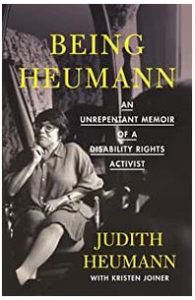 Judith Heumann is a thoughtful and very intelligent woman, who has had a remarkable career dedicated to the civil rights of people with disabilities in the US and around the world. The details of her life and of the struggle are fascinating. Pub date 2020
Judith Heumann is a thoughtful and very intelligent woman, who has had a remarkable career dedicated to the civil rights of people with disabilities in the US and around the world. The details of her life and of the struggle are fascinating. Pub date 2020
 This is a fascinating book, about the importance of books, about readers and writers, with complex romances thrown in. The writing is lovely, and there’s a strong sense of place and era. The characters are interesting and unique. I found the structure, with alternate points of view of two rather similar characters, a bit confusing, and as usual was defeated by the mystery genre. But if you enjoy intelligent, original mysteries, I certainly recommend this.Pub date 2019
This is a fascinating book, about the importance of books, about readers and writers, with complex romances thrown in. The writing is lovely, and there’s a strong sense of place and era. The characters are interesting and unique. I found the structure, with alternate points of view of two rather similar characters, a bit confusing, and as usual was defeated by the mystery genre. But if you enjoy intelligent, original mysteries, I certainly recommend this.Pub date 2019
|
|
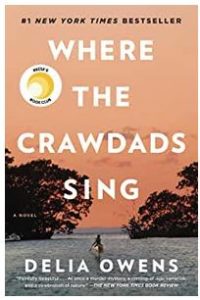 The author took me into the marsh, and into the life of a little girl, then woman, repeatedly abandoned, who had to learn to fend for herself, trusting almost no one. This book deserves the acclaim it’s received. The writing, especially the nature writing, is as good as it gets. I found the rapid summation of the last forty years of the protagonists life jarring, but I loved the twist at the end.Pub date 2018
The author took me into the marsh, and into the life of a little girl, then woman, repeatedly abandoned, who had to learn to fend for herself, trusting almost no one. This book deserves the acclaim it’s received. The writing, especially the nature writing, is as good as it gets. I found the rapid summation of the last forty years of the protagonists life jarring, but I loved the twist at the end.Pub date 2018
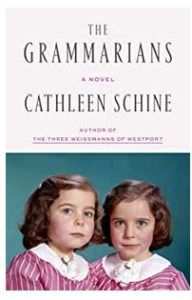 This novel is about family, twins, and words. Laurel and Daphne, identical twins, understand each others’ infant babble, which delights and disturbs their family. They remain linked to each other and obsessed with language until one has a baby and plunges into all-consuming early motherhood. The rift grows wider through the years. The book felt a bit contrived, as though the plot and characters had come from a What If? idea rather than growing organically.
This novel is about family, twins, and words. Laurel and Daphne, identical twins, understand each others’ infant babble, which delights and disturbs their family. They remain linked to each other and obsessed with language until one has a baby and plunges into all-consuming early motherhood. The rift grows wider through the years. The book felt a bit contrived, as though the plot and characters had come from a What If? idea rather than growing organically.
Anyone who delights in words for their own sake will enjoy it as I did. (I collect appealing words from the OED see https://elizabethmccullochauthor.com/?s=A+Gift+from+Doris) Pub. date 2019
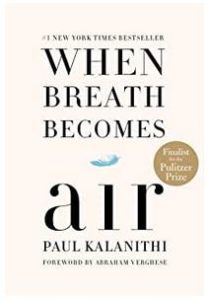 Kalanithi left us all a wonderful gift – a searching probe of the doctor’s role and the place of death and dying in our lives. In his short life, he was torn between science and writing; in this book he writes of deep moral issues in medicine with the pen of a poet. Pub date 2016
Kalanithi left us all a wonderful gift – a searching probe of the doctor’s role and the place of death and dying in our lives. In his short life, he was torn between science and writing; in this book he writes of deep moral issues in medicine with the pen of a poet. Pub date 2016
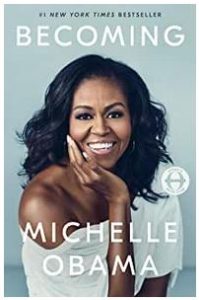 I had a crush on Michelle Obama from the moment she stepped reluctantly onto the public stage. This well-written (NOT ghost-written) memoir confirmed my admiration, revealing her warmth, intelligence, passion, and determination. Campaign PR and media told us the broad outline of her life, but now we hear her own clear voice. The childhood nourished by a warm extended family, her determined success in school, college, law school, the search for meaningful work, her marriage and motherhood, and the life she never sought as politician’s and then President’s wife. The story of life in the White House is full of fascinating anecdotes and characters who come alive in her telling. She doesn’t hide her doubts and struggles, but she is a woman with strong values, who makes her own happiness, regardless of the circumstances she finds herself in. Pub date 2018
I had a crush on Michelle Obama from the moment she stepped reluctantly onto the public stage. This well-written (NOT ghost-written) memoir confirmed my admiration, revealing her warmth, intelligence, passion, and determination. Campaign PR and media told us the broad outline of her life, but now we hear her own clear voice. The childhood nourished by a warm extended family, her determined success in school, college, law school, the search for meaningful work, her marriage and motherhood, and the life she never sought as politician’s and then President’s wife. The story of life in the White House is full of fascinating anecdotes and characters who come alive in her telling. She doesn’t hide her doubts and struggles, but she is a woman with strong values, who makes her own happiness, regardless of the circumstances she finds herself in. Pub date 2018
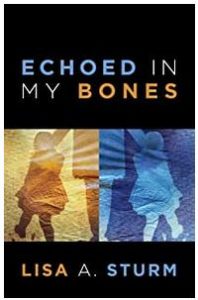 This is a novel about mothers and daughters, abandonment and loss, class and race. A 16-year-old girl, herself abandoned by her mother, gives up her twin biracial infants. One adopted, the other in foster care, their lives take very different paths. The story grabs you from the very beginning, and will not let go. The author draws her knowledge of these three from her work as a family therapist, but there is no hint of case study or analysis in her writing. These three women are deeply imagined and loved by the author. Each of them entered my heart, and will stay there. The book is a page-turner in the best sense of the words. Pub date 2020
This is a novel about mothers and daughters, abandonment and loss, class and race. A 16-year-old girl, herself abandoned by her mother, gives up her twin biracial infants. One adopted, the other in foster care, their lives take very different paths. The story grabs you from the very beginning, and will not let go. The author draws her knowledge of these three from her work as a family therapist, but there is no hint of case study or analysis in her writing. These three women are deeply imagined and loved by the author. Each of them entered my heart, and will stay there. The book is a page-turner in the best sense of the words. Pub date 2020
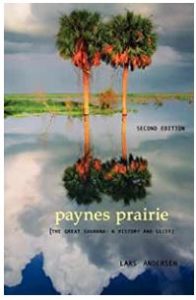 Lars Andersen, a north Florida nature guide and kayak expedition leader, wrote this wonderful book about Payne’s Prairie, the huge savannah just south of Gainesville, Florida, a state park and US national natural landmark. He begins with the formation of the Florida peninsula, proceeds through the amazing fauna that roamed the land – 15-foot sloths, saber tooth cats, and more, continues with the tales of the battling humans – native and European, who struggled for dominion, and brings us up to the present day. It’s a lot of information, but he presents it with a light touch, warm humor, and a deep love of this place. Cattle have grazed and excursion steamboats have sailed on the Prairie by turns, as it was formed and transformed by sinkholes, and in modern times people have struggled both to exploit it and protect it. If you like to read about nature, magical places, or Florida, you’ll love this book as I do. (It gave me all sorts of ideas for Dreaming the Marsh.) Pub date 2003
Lars Andersen, a north Florida nature guide and kayak expedition leader, wrote this wonderful book about Payne’s Prairie, the huge savannah just south of Gainesville, Florida, a state park and US national natural landmark. He begins with the formation of the Florida peninsula, proceeds through the amazing fauna that roamed the land – 15-foot sloths, saber tooth cats, and more, continues with the tales of the battling humans – native and European, who struggled for dominion, and brings us up to the present day. It’s a lot of information, but he presents it with a light touch, warm humor, and a deep love of this place. Cattle have grazed and excursion steamboats have sailed on the Prairie by turns, as it was formed and transformed by sinkholes, and in modern times people have struggled both to exploit it and protect it. If you like to read about nature, magical places, or Florida, you’ll love this book as I do. (It gave me all sorts of ideas for Dreaming the Marsh.) Pub date 2003
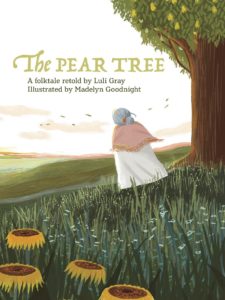 The late Luli Gray left us another twist on an old fable. In Ant and Grasshopper, she turned punitive judgment into a celebration of humane values, friendship, and the richness of diverse gifts. In The Pear Tree, she gives us an old woman, Tia Esperanza (hope), who tries to trick Death, but eventually realizes that he carries out a necessary mission. In the original Spanish folktale, the old woman was Tia Miseria (misery) but in Luli Gray’s version we learn that despite death, there will always be hope in the world. Madelyn Goodnight has illustrated the story with beautiful scenery and vivid characters that enhance the sense of folktale magic. Pub. date 2019
The late Luli Gray left us another twist on an old fable. In Ant and Grasshopper, she turned punitive judgment into a celebration of humane values, friendship, and the richness of diverse gifts. In The Pear Tree, she gives us an old woman, Tia Esperanza (hope), who tries to trick Death, but eventually realizes that he carries out a necessary mission. In the original Spanish folktale, the old woman was Tia Miseria (misery) but in Luli Gray’s version we learn that despite death, there will always be hope in the world. Madelyn Goodnight has illustrated the story with beautiful scenery and vivid characters that enhance the sense of folktale magic. Pub. date 2019
 I just reread this. I first read it back when I was young, and I think I got a lot more from it this time. The three little girls – the two sisters and the outcast – are so real, and the story pretty excruciating. I plan to read more Morrison bit by bit (those in my bookcase, and Jazz) but I have had a couple of bouts of book buying on Indiebooks, and I’m drowning in tempting reading. Pub. date 1970
I just reread this. I first read it back when I was young, and I think I got a lot more from it this time. The three little girls – the two sisters and the outcast – are so real, and the story pretty excruciating. I plan to read more Morrison bit by bit (those in my bookcase, and Jazz) but I have had a couple of bouts of book buying on Indiebooks, and I’m drowning in tempting reading. Pub. date 1970
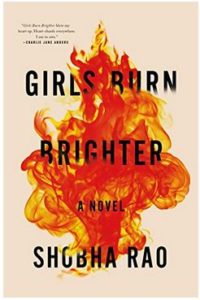 At first I felt a bit as though I were reading a thinly-diguised, well-written social studies lecture on life among the very poor people of rural India. But soon the two main characters drew me in: their love, the horrors of their lives, and their harrowing separate quests for each other as they are enslaved by human traffickers. Complex, unique characters, beautiful nature writing, and recurring images – a crow with a warning, a precious scrap of a sari – lift it well beyond a documentary study. It is a powerful and suspenseful book; you will need a strong stomach to read it. Pub date 2018
At first I felt a bit as though I were reading a thinly-diguised, well-written social studies lecture on life among the very poor people of rural India. But soon the two main characters drew me in: their love, the horrors of their lives, and their harrowing separate quests for each other as they are enslaved by human traffickers. Complex, unique characters, beautiful nature writing, and recurring images – a crow with a warning, a precious scrap of a sari – lift it well beyond a documentary study. It is a powerful and suspenseful book; you will need a strong stomach to read it. Pub date 2018
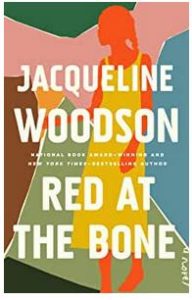 I don’t understand how in fewer than 200 pages, Jacqueline Woodson gives us such full and moving characters, members of several generations of two families, their dreams and choices, the histories that haunt them. She goes back and forth in time as she unwinds the plot, but I never lost track. The smooth beautiful prose is what I would expect from her, but I still kept puzzling over, “How does she do it?” A lovely, moving, engrossing story. Pub date 2019
I don’t understand how in fewer than 200 pages, Jacqueline Woodson gives us such full and moving characters, members of several generations of two families, their dreams and choices, the histories that haunt them. She goes back and forth in time as she unwinds the plot, but I never lost track. The smooth beautiful prose is what I would expect from her, but I still kept puzzling over, “How does she do it?” A lovely, moving, engrossing story. Pub date 2019
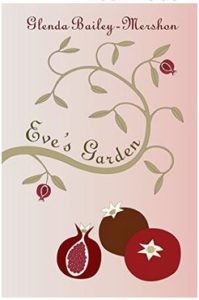 This is a complex, beautifully written story about a woman’s search to understand her family history and figure out family mysteries and secrets. Its view into the world of Romani Americans was new to me and consistently fascinating. Pub date 2014
This is a complex, beautifully written story about a woman’s search to understand her family history and figure out family mysteries and secrets. Its view into the world of Romani Americans was new to me and consistently fascinating. Pub date 2014
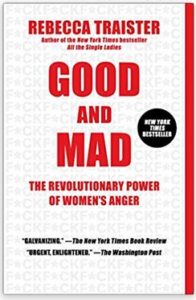 Good and Mad focuses on women’s political fervor following the election of Donald Trump: the 2017 Women’s March, the #MeToo movement, and the explosive growth in women running for office, the great majority of them Democrats. It also gives us history. Traister analyzes the role of women’s anger in the long fight for suffrage, and the racist anger of white suffragists when black men won the franchise first. She discusses the Second Wave women’s movement of the 1960’s and 70’s, and black women’s anger as their leadership was ignored by both their allies and the media. To me, Traister’s book brings encouragement, hope, and maybe even a little bit of activist energy. I believe in the generative power of our anger; there is a difference between fire that rages uncontrolled and fire you use as a tool. Pub. date 2018
Good and Mad focuses on women’s political fervor following the election of Donald Trump: the 2017 Women’s March, the #MeToo movement, and the explosive growth in women running for office, the great majority of them Democrats. It also gives us history. Traister analyzes the role of women’s anger in the long fight for suffrage, and the racist anger of white suffragists when black men won the franchise first. She discusses the Second Wave women’s movement of the 1960’s and 70’s, and black women’s anger as their leadership was ignored by both their allies and the media. To me, Traister’s book brings encouragement, hope, and maybe even a little bit of activist energy. I believe in the generative power of our anger; there is a difference between fire that rages uncontrolled and fire you use as a tool. Pub. date 2018
 Bryan Stevenson is one of my long-time heroes – defending death row inmates in the South – an amazing and beautiful man. In this book he shows us the ugly and naked truths of criminal “justice” for the poor, and bares his own soul. Pub date 2015
Bryan Stevenson is one of my long-time heroes – defending death row inmates in the South – an amazing and beautiful man. In this book he shows us the ugly and naked truths of criminal “justice” for the poor, and bares his own soul. Pub date 2015
